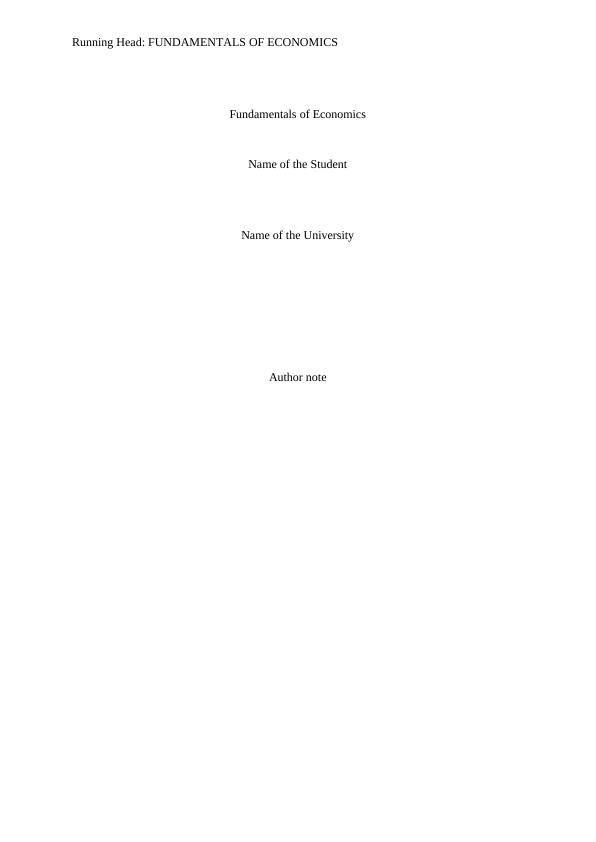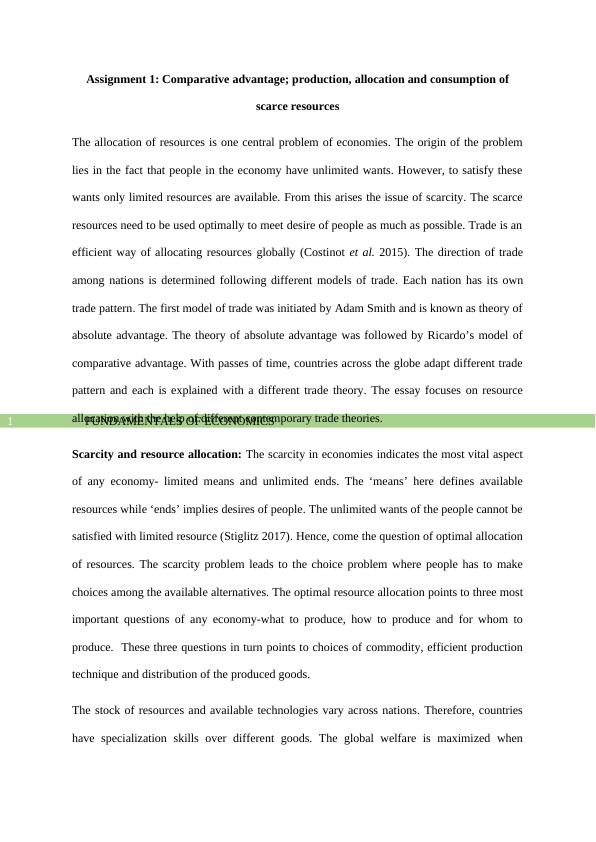Fundamentals of Economics PDF
11 Pages2464 Words33 Views
Added on 2021-04-16
Fundamentals of Economics PDF
Added on 2021-04-16
ShareRelated Documents
Running Head: FUNDAMENTALS OF ECONOMICSFundamentals of EconomicsName of the StudentName of the UniversityAuthor note

FUNDAMENTALS OF ECONOMICS1Assignment 1: Comparative advantage; production, allocation and consumption ofscarce resourcesThe allocation of resources is one central problem of economies. The origin of the problemlies in the fact that people in the economy have unlimited wants. However, to satisfy thesewants only limited resources are available. From this arises the issue of scarcity. The scarceresources need to be used optimally to meet desire of people as much as possible. Trade is anefficient way of allocating resources globally (Costinot et al. 2015). The direction of tradeamong nations is determined following different models of trade. Each nation has its owntrade pattern. The first model of trade was initiated by Adam Smith and is known as theory ofabsolute advantage. The theory of absolute advantage was followed by Ricardo’s model ofcomparative advantage. With passes of time, countries across the globe adapt different tradepattern and each is explained with a different trade theory. The essay focuses on resourceallocation with the help of different contemporary trade theories. Scarcity and resource allocation: The scarcity in economies indicates the most vital aspectof any economy- limited means and unlimited ends. The ‘means’ here defines availableresources while ‘ends’ implies desires of people. The unlimited wants of the people cannot besatisfied with limited resource (Stiglitz 2017). Hence, come the question of optimal allocationof resources. The scarcity problem leads to the choice problem where people has to makechoices among the available alternatives. The optimal resource allocation points to three mostimportant questions of any economy-what to produce, how to produce and for whom toproduce. These three questions in turn points to choices of commodity, efficient productiontechnique and distribution of the produced goods. The stock of resources and available technologies vary across nations. Therefore, countrieshave specialization skills over different goods. The global welfare is maximized when

FUNDAMENTALS OF ECONOMICS2countries specializing in different goods exchange goods. This line of specialization can bedetermined based on absolute cost advantage, relative cost advantage, relative factorabundance and others ((Feenstra 2015). Each of this aspect is taken care of separate tradetheories. Absolute and comparative advantage:Adam Smith developed the theory of absoluteadvantage. The theory states that when a country is able to produce one good at a lower costas compared other nations then the country is said to have an absolute advantage over thegood. When a country has absolute advantage in a good then it can make the good byemploying a relatively smaller amount of resource (Costinot et al. 2015). Countries thuswhen specialize following principles of absolute advantage and trade with each other;resources are used optimally raising world welfare. The problem arises when one country has absolute advantages over others on all product. TheSmith’s theory then fails to explain any trade pattern between countries. When absolute costdifference cannot determine the trade direction then the alternative approach is to computethe opportunity cost. David Ricardo first develops trade theory in terms of opportunity cost.The trade model developed by Ricardo is known as theory of comparative advantage. Thecomparative advantage of a nation is the ability to produce a good a lower opportunity costthan other nation. Involving in trade following principles of comparative advantage ismutually beneficial for both the trade partners. Both the participating nations are benefittedfrom comparative advantage and world output as a whole increase (Feenstra 2015). Countrieswhen specializes in goods that has a lower opportunity cost then the resource waste isminimized. Following an efficient resource allocation and higher world output, more goodsare available for consumption satisfying more wants and thus stimulate world’s welfare.

FUNDAMENTALS OF ECONOMICS3The concept of comparative advantage and the involved opportunity cost will become clearerwith the help of the following example. The table below shows the required labor hours for producing wheat and cotton in twonations namely China and US. Labor hours(for producing 1 unit )WheatCottonChina105US82For producing 1 unit of wheat and cotton the required labor hours for China are 10 and 2respectively. While US requires a relatively less labor hour for producing both wheat andcotton. For wheat, the required labor hour is 8 while for cotton it is 2. This implies US hasabsolute advantage over China for both Wheat and Cotton. No trade relation therefore can bedefined from the theory of absolute advantage. Trade however is possible by taking intoconsideration the associated opportunity cost. Opportunity cost(for producing 1 unit )WheatCottonChina10/5 = 25/10 = 0.5US8/2 = 42/8 = 0.25 For China, the opportunity cost of wheat is only 2 units of cotton while for US the involvedopportunity cost for wheat is 4 units of cotton. Following a lower opportunity cost Chinashould specialize in Wheat. For cotton however US has a lower opportunity cost (0.25 < 0.5)and hence should specialize in cotton. From specialization, China gains 5 hours of labor that it requires to produce cotton. US gains6 units of labor hours. Both the countries when specializes as per their comparative advantage

End of preview
Want to access all the pages? Upload your documents or become a member.
Related Documents
Assignment on Fundamentals of Economics (pdf)lg...
|12
|2833
|374
Fundamentals of economics assignmentlg...
|12
|2348
|33
Theory of comparative advantage and allocation of scarce resourceslg...
|11
|2741
|217
Fundamentals of economics - assignmentlg...
|12
|2796
|25
(PDF) Fundamental of Economicslg...
|13
|3045
|348
Assignment on Economic in UKlg...
|15
|2255
|45
